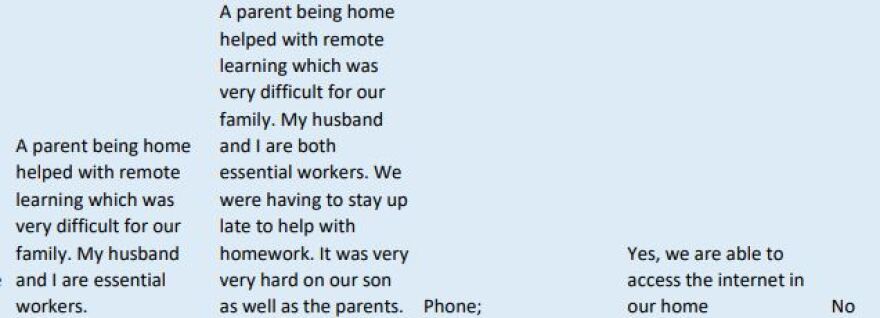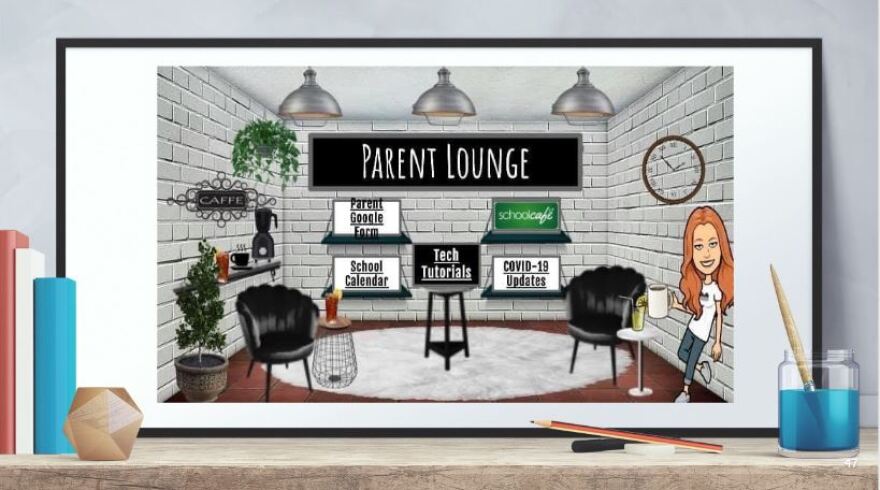As the pandemic began to surge, schools closed and most students switched to online learning almost overnight. Schools with less access to technology relied on paper packets, especially for elementary students.
It was more like crisis teaching, like building the plane as you’re flying it. That’s how Lindsay Zelly described sudden changeover. She’s the director of professional learning at the Illinois Digital Educators Alliance. They provide professional development and online resources to teachers.
“They didn't really have time to figure out all the little nuances that come with lesson planning remotely and meeting the needs of learners in an online setting or perhaps even reaching learners who don't have access to the internet,” she said.
Rockford Superintendent Ehren Jarrett said in May that 1,200 families didn’t have adequate internet service.
The Dixon Community School District solicited a parent survey asking about the biggest challenges their kids faced learning from home. Through a Freedom of Information Act request, WNIJ obtained hundreds of responses. They show worries over a range of issues.
Spotty internet frustrated families. Parents wrote about their kids juggling a single device for their school work.
Educators were often praised for helping them get through assignments, while numerous parents cited a lack of teacher interaction as a major issue.
Child care was one of their biggest concerns. The United States is seeing a child care crisis during COVID-19, and it’s no different for northern Illinois parents.

A parent of an elementary school student wrote, “My child gets passed around to 5 people/houses for child care depending on who’s available to watch them.”
A Dixon middle school family said, “My husband and I are both essential workers. We were having to stay up late to help with homework. It was very, very hard on our son as well as the parents.”
That problem hasn’t been solved for schools starting out online this fall. Child care is expensive and could put low-income families in a bind.
Districts like DeKalb are trying to offer options. Interim superintendent Griff Powell said they’re partnering with several child care organizations including the YMCA who can also help students with remote learning.
“We have reached and we are actually housing some of those activities in a couple of our buildings,” said Powell.
Online learning in the fall will look considerably different than last spring. For one, it’ll be longer: the Illinois State Board of Education is mandating five hours of remote learning. Two and a half hours of it must be synchronized with the class working at the same time.

Some school districts prioritized professional development for their teachers. That’s so they would feel better prepared to implement a remote learning curriculum.
In a district survey, 64% of Freeport teachers said they needed more of that help. A third of those same teachers said they see themselves as beginners, defined as “who know the basics but not much more” or just slightly above that when it comes to teaching new material online.
Lindsay Zelly said the Illinois Digital Educators Alliance held online sessions through the spring and summer.
“A big point that I try and make to teachers is to do less. It's hard to connect with learners,” said Zelly. “So pick the thing that you're passionate about, and teach that first because that passion is going to reach students beyond the screen much better than, you know, 'Unit One, Lesson One.'”
The Illinois Digital Educators Alliance also held presentations for parents looking to help their kids with remote learning, getting them acquainted with the tools and technology they’ll use.
A few northern Illinois schools are going totally online except for certain special needs students who need hands-on help. DeKalb is not doing that. Instead, it’s deploying staff to assist those students online.
“Many of our paraprofessionals have been assigned to assign specific students with like with an IEP [Independent Education Plan],” said Powell.
The other key difference between the spring and fall? Grading. In April, Illinois decided grades wouldn’t count for or against students. It made it difficult for some to stay motivated, and engagement often nosedived as the virtual year ended.
By the end, participation at some Rockford elementary schools fell below 20%. Only 25% of DeKalb students were present and logged in for all 29 e-learning days. But, numbers at other schools hovered in the 80s and even 90s.

The typical letter grading system will be back this fall, much closer to a typical school year. Griff Powell said that’s one reason he thinks participation will be much better.
The other reason is that now a lot of teachers say they feel much more comfortable teaching online. And they’re already finding creative ways to make the most of that space.
Educators are experimenting with “Bitmoji classrooms,” digital hubs with cartoons that double as clickable links for students to explore resources. Maybe a bookshelf that links to the library.
Lindsay Zelly said it’s impossible to recreate the classroom experience online. But schools can still try to bring a little normalcy -- in a year that has been the furthest thing from ‘normal.’


